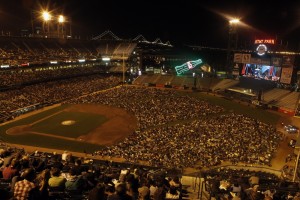The following is a guest post by Emmy-Award-winning engineer Mark Schubin. He has been writing about the intersecting histories of opera and media technology since 1972 and currently serves as engineer-in-charge of the Metropolitan Opera’s Media Department. In October 2011, Mark gave a presentation at the Library on the “Fandom of the Opera: How a 400-year-old Art Form Helped Create Modern Media Technology.” You can view his lecture as a webcast or on our YouTube channel.
Speaking at his induction into the National Baseball Hall of Fame in 1976, Cleveland pitcher Bob Lemon (1920-2000) told of being introduced to the game (and his future team) when only a few weeks old. But Lemon was born before television and even before the first baseball game on radio so his mother took him to ‘watch’ the World Series at the Redlands (California) Opera House. Fans had already been watching live baseball games remotely at opera houses for more than 35 years.
Transmission was via telegraph and displays varied. The May 27, 1885 issue of The Sporting Life told of a system in Augusta, Georgia- “We have a blackboard in the Opera House and a diamond on it, with holes punched for each base, with flags showing how each base runner gets his base, with the batting order of each nine. The whole game is sent by telegraph, showing how each player plays. They charge ten cents for each day.”
At DeGive’s Opera House in Atlanta in 1886, boys in uniforms recreated plays on a stage-sized ball field. According to the Detroit Free Press on July 9, 1886, the Detroit Opera House had “a drop curtain having a well painted perspective view of a base ball diamond and outfield,” and “there came a storm of applause, just such as is heard on a veritable ball field.” By then fans also watched baseball games at opera houses in Boston, Chicago, Cincinnati, and Nashville.
In 1891 electric light and motors were added. When their local team beat New York in 1894, the crowd at Ford’s Opera House in Baltimore was driven wild by the Compton Electric Base Ball Game Impersonator. And that year another new technology was introduced: android robotics.
On May 7, 1895, the Richmond Times quoted a woman watching a game via Samuel Crowder’s Little Men at Mozart’s Academy of Music. “Why they bow just as sweetly as ‘real live men’ when applauded.” The Electrical Engineer, in its August 7, 1895 issue (p.145-146), described Frank Chapman’s “Automatic Baseball by Electricity.” After connecting, a hitter would lose his “bat which he flings down with a genuinely ‘sickening thud’ when he starts for first base.” A player on base could “move his legs so that he seems to be running, and of course he can be seen in the very act of trying to steal the next base.” Different systems were said to be able to show players warming up, being coached, sliding (and, if it happened, breaking a leg), arguing with the umpire, and clapping and dancing after good plays.
The Nokes Electrascore (1912) used 1500 light bulbs that could depict the arc of a ball. The Coleman Life-Like Scoreboard (1913) used 400 projectors. Between 1899 and 1927, at least 44 U.S. patents were issued for these remote baseball viewing systems, and some of the most popular weren’t patented.
Into the 1930s, the Arizona Daily Star was still sponsoring World Series viewing on an Automatic Base Ball Play-O-Graph at the Tucson Opera House, but newer media were taking over. In 1934, World Series radio-broadcast rights were first sold, and in 1939 the first U.S. baseball game was televised.
Meanwhile, opera was performed at the legendary Polo Grounds ball park in New York in 1923 and spread to other stadiums. A 1988 Aida at Olympic Stadium in Montreal (then home of the Expos) might have attracted the largest opera audience. But it was one of the last, until media technology helped out.

32,000 fans watching "Aida" at the AT&T Ballpark (San Francisco), 2010. Photograph by Cory Weaver- used by permission from the San Francisco Opera.
In 2007 San Francisco Opera transmitted a live performance in HDTV to the LED scoreboard at AT&T Park. The following year, Washington National Opera did the same at Nationals Park.
Even if fans no longer watch baseball at opera houses, they’re watching opera at baseball stadiums.
Turnabout is fair play.
For more information about early baseball media technology see Mark Schubin’s Watching Baseball Games before TV and his Baseball/Opera Chronology. For more general historical baseball resources see the Library’s Historic Baseball Resources page and guide to Baseball Resources at the Library of Congress.




